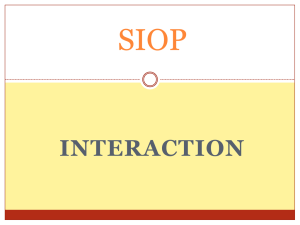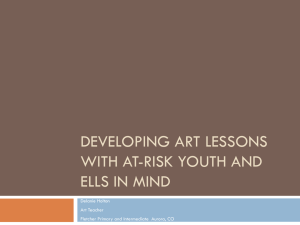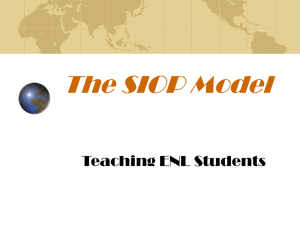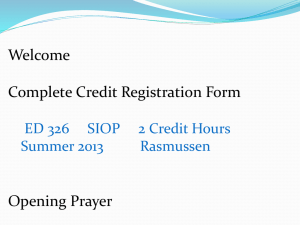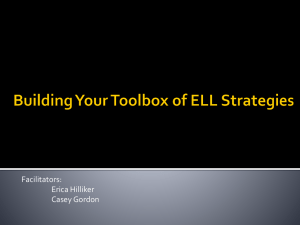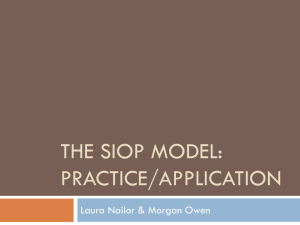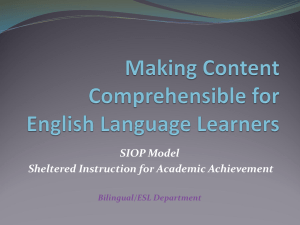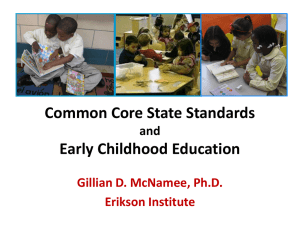Common Core and ELLs - Mrs. Hilliker`s ELL and SIOP Toolbox
advertisement
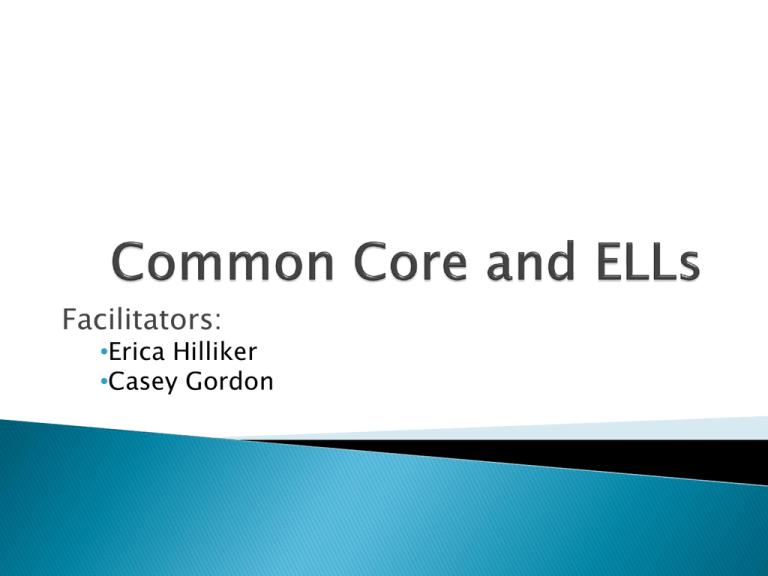
Facilitators: •Erica Hilliker •Casey Gordon Content Objectives: ◦ We will examine CCSS Guidelines for the instruction of ELLs. ◦ We will compare CCSS ELL Guidelines to the SIOP Model. ◦ We will apply SIOP strategies that correlate to the recommended CCSS guidelines. Language Objectives: ◦ We will read the CCSS Guidelines for the instruction of ELLs. ◦ We will write and discuss correlations of CCSS ELL Guidelines and the SIOP Model. ◦ We will orally evaluate the effectiveness of specific SIOP strategies for teaching CCSS. Common Core State Standards Overview Language Arts Guidelines Math Guidelines SIOP Correlations SIOP Strategies for teaching CCSS Carousel Brainstorming: 1. Discuss and record ideas related to the topic on the poster at the center of your table. 2. When the time is up, rotate to the next table. Read the ideas written on the poster and add 2 or 3 additional ideas. 3. Repeat the process until you have visited all of the posters. 4. Discuss as a whole group. Common Core ELA / Literacy Common Core Math Next Generation Science Standards Michigan English Language Proficiency Standards ◦ Will be replaced by WIDA Standards 3 page document “Teachers should recognize that it is possible to achieve the standards for reading and literature, writing & research, language development and speaking & listening without manifesting nativelike control of conventions and vocabulary.” “However, these students may require additional time, appropriate instructional support, and aligned assessments as they acquire both English language proficiency and content area knowledge.” ELLs require “appropriate instructional support.” What does that mean? ◦ Incorporate a literacy-rich classroom environment where students are immersed in a variety of language experiences. ◦ Develop foundational skills in English and enable ELLs to participate fully in grade-level coursework ◦ Include coursework that prepares ELLs for postsecondary education or the workplace, yet is made comprehensible for students learning content in a second language (through specific pedagogical techniques and additional resources) ◦ Provide opportunities for classroom discourse and interaction that are well-designed to enable ELLs to develop communicative strengths in language arts. ◦ Include ongoing assessment and feedback to guide learning. ◦ Involve speakers of English who know the language well enough to provide ELLs with models and support. Draw on multiple resources and modes available in classrooms-such as objects, drawings, inscriptions, and gestures-as well as home languages and mathematical experiences outside of school. Focus on “mathematical discourse” and “academic language” because these are important for ELLs. Require student negotiation of meaning for mathematical situations and in mathematical practices that involve output from students. Involve regular and active participation in the classroom- not only reading and listening but also discussing, explaining, writing, representing, and presenting Ensure that students understand the text of word problems before they attempt to solve them. How do the CCSS guidelines for the instruction of ELLs correlate to the SIOP Model? 1. 2. 3. Incorporate a literacy-rich classroom environment where students are immersed in a variety of language experiences. Develop foundational skills in English and enable ELLs to participate fully in grade-level coursework. Include coursework that prepares ELLs for postsecondary education or the workplace, yet is made comprehensible for students learning content in a second language (through specific pedagogical techniques and additional resources) CCSS Guidelines 1. 2. 3. The SIOP Model fosters the development of all language domains: reading, writing, listening, and speaking. The SIOP Model encourages the use of scaffolding which allows ELLs to complete grade-level assignments. The Lesson Preparation and Comprehensible Input components of the SIOP Model address techniques that teachers can use to make the curriculum accessible to ELLs. SIOP Model 4. Provide opportunities for classroom discourse and interaction that are welldesigned to enable ELLs to develop communicative strengths in language arts. 5. Include ongoing assessment and feedback to guide learning. 6. Involve speakers of English who know the language well enough to provide ELLs with models and support. CCSS Guidelines 4. The interaction component of the SIOP Model addresses techniques for increasing classroom discourse. 5. The review and assessment component of the SIOP Model provides suggestions for assessing ELLs. 6. The SIOP Model addresses grouping configurations that support language development. SIOP Model 1. Draw on multiple resources and modes available in classroomssuch as objects, drawings, inscriptions, and gestures-as well as home languages and mathematical experiences outside of school. 2. Focus on “mathematical discourse” and “academic language” because these are important for ELLs. 3. Require student negotiation of meaning for mathematical situations and in mathematical practices that involve output from students. CCSS Guidelines 1. 2. 3. The SIOP Model promotes the use of supplementary materials for ELLs. The SIOP Model provides strategies for promoting Academic Language in the classroom. The SIOP Model incorporates meaningful activities that integrate lesson concepts with language practice opportunities. SIOP Model 5. Involve regular and active participation in the classroom- not only reading and listening but also discussing, explaining, writing, representing, and presenting. 6. Ensure that students understand the text of word problems before they attempt to solve them. 5. The SIOP model provides interaction strategies that incorporate all four language domains: reading, writing, speaking, and listening. 6. The SIOP model provides techniques for the adapting content to the levels of student proficiency. CCSS Guidelines SIOP Model T=Title ◦ What is the title?, What do I already know about this topic?, What does this topic have to do with the preceding chapter? Does the title express a point of view?, What do I think I will be reading about? H= Headings/Subheadings ◦ What does this heading tell me I will be reading about?, What is the topic of the paragraph beneath it? How can I turn this heading into a question that is likely to be answered in the text? I= Introduction ◦ Is there an opening paragraph, perhaps italicized?, Does the first paragraph introduce the chapter? What does the introduction tell me I will be reading about? E=Every First Sentence ◦ What do I think this chapter is going to be about, based on the first sentence in each paragraph? V= Visuals and Vocabulary ◦ Does the chapter include photographs, drawings, maps, charts, or graphs?, What can I learn from the visuals in a chapter?, How do captions help me better understand the meaning?, Is there a list of key vocabulary terms and definitions?, Are there important words in boldface type throughout the chapter? Do I know what the bold-faced words mean?, Can I tell the meaning of the boldfaced words from the sentences in which they are embedded? E= End of Chapter Questions ◦ What do the questions ask?, What information do I learn from the questions?, Let me keep in mind the end-of-chapter questions so that I may annotate my text where pertinent information is located. S= Summary ◦ What do I understand and recall about the topics covered in the summary? Using the THIEVES worksheet, preview the chapter “How the Body Digests Food”. Why would THIEVES be an appropriate strategy for teaching the CCSS? How would could you adapt it for your content area or grade level? Shh! This is a secret – do not share with others yet. Select a concept related to weather. Write the concept on an index card. Write 3 words below that are closely related to that concept. Trade cards with someone at your table. Find someone in the room wearing the same color as you and describe your concept *without* using any of the words on the card. Tornado Twister, wind, funnel Why would Taboo be an appropriate strategy for teaching the CCSS? How would could you adapt it for your content area or grade level? 1. 2. 3. 4. Find a colleague who can answer each of the questions on your sheet. Listen to your colleague’s answer and record it on your sheet. Then, have your colleague initial under his/her answer. Each person can initial your sheet no more than two times. You “win” when you get all of the boxes filled out on your sheet. Why would People Hunt be an effective strategy for teaching the CCSS? How would you adapt it to fit your content area or grade level? a decision by a person in authority to not allow or approve something -Power of the President or Governor - part of Checks & Balances system - can be Line Item or Pocket Veto Veto Shoot down, reject Confirm, ratify 1. 2. 3. Each of you has a piece of a Frayer Model. Locate the people in the room with the other pieces you need to complete your Frayer Model. When the puzzle is complete, each group should have 5 pieces: -Vocabulary Word - Definition Characteristics Examples Non-Examples Why are the Frayer Model and the Frayer Model Puzzle effective strategies for teaching the CCSS? How would you adapt them to fit your content area or grade level? 1. 2. 3. 4. Select two vocabulary words from your list that are related. Using the words you selected, write a sentence using the following frame: I would connect _________ and ________ because _____________. Discuss the sentence you have written with a partner. Be prepared to share your sentence with the rest of the group. Hot Tall Hard Cold Short Soft Mama Bear Papa Bear Baby Bear Goldilocks Tired Hungry Scared Porridge Broke Bowls Beds Just Right Sleeping Eating Why would Connect Two be an effective strategy for teaching the CCSS? How would you adapt it to fit your content area or grade level? Content Objectives: ◦ We will examine CCSS Guidelines for the instruction of ELLs. ◦ We will compare CCSS ELL Guidelines to the SIOP Model. ◦ We will apply SIOP strategies that correlate to the recommended CCSS guidelines. Language Objectives: ◦ We will read the CCSS Guidelines for the instruction of ELLs. ◦ We will write and discuss correlations of CCSS ELL Guidelines and the SIOP Model. ◦ We will orally evaluate the effectiveness of specific SIOP strategies for teaching CCSS.
